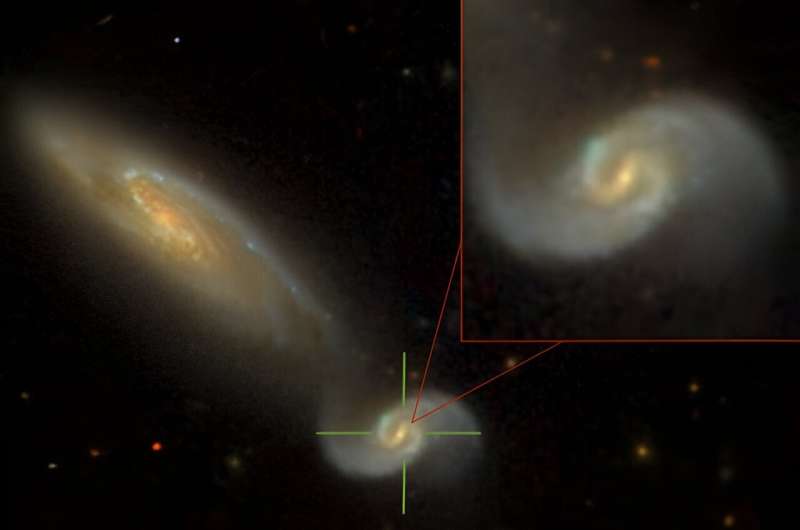An international team of astronomers recently conducted multiwavelength observations of AT 2023clx, the closest tidal disruption event (TDE) to Earth. TDEs occur when a star is pulled apart by the tidal forces of a supermassive black hole. The results of this observational campaign provide crucial insights into the properties of AT 2023clx.
Background on Tidal Disruption Events (TDEs)
TDEs are astronomical phenomena where a star passes close to a supermassive black hole, leading to its disruption. This results in stellar debris being pulled towards the black hole, emitting radiation from the innermost region of accreting debris, indicating the presence of a TDE.
AT 2023clx – Closest Optical TDE
AT 2023clx, located in the nucleus of the galaxy NGC 3799, is the closest known optical TDE, situated approximately 155.8 million light years away. Initially identified as a transient in 2014, it was officially classified as a TDE in July 2023. Despite its proximity, AT 2023clx is among the faintest known tidal disruption events.
Astronomical Observations and Instruments
To gain a deeper understanding of AT 2023clx, astronomers led by Panos Charalampopoulos of the University of Turku conducted a comprehensive study using optical, near-infrared, and ultraviolet bands. Various space telescopes and ground-based observing facilities, such as NASA’s Swift spacecraft and the Nordic Optical Telescope, were employed for this purpose.
Photometric and Spectroscopic Analysis
The researchers presented a thorough photometric and spectroscopic analysis of AT 2023clx in their paper. The observations revealed important details about the event.
Findings and Properties of AT 2023clx
The observations found that AT 2023clx had a peak absolute magnitude of −18.25 mag in the g-band and a maximum bolometric luminosity at a level of 32.4 tredecillion erg/s, classifying it as an intermediate luminosity TDE. The mass of the supermassive black hole involved was estimated to be around 1 million solar masses.
Unique Characteristics of AT 2023clx
AT 2023clx exhibited unique characteristics, including its rapid rise to peak luminosity within 10.4 days, making it the fastest rising TDE known to date. This speed suggests the disruption of a very low-mass star (below 0.1 solar masses) with a specific impact parameter.
Spectroscopic Analysis
Spectroscopy revealed a blue continuum that cools slowly and broad Balmer and helium lines, typical of tidal disruption events. The lines gradually narrowed with time as luminosity decreased, consistent with known TDE behavior.
Novel Observation
Observations of AT 2023clx identified a sharp, narrow emission peak at a rest wavelength of about 6353 Å, located on the blue side of the broad hydrogen-alpha profile. This feature represents a novel finding in TDEs.
Summary and Conclusions
In summary, the researchers concluded that AT 2023clx resulted from the tidal disruption of a low-mass, small-radius star with low central concentration, close to full disruption but below the critical value. They noted that such disruptions should exhibit a sharper rise and a shallower decline in the light curves compared to other disruptions.
Multiple-Choice Questions (MCQs):
- What is a Tidal Disruption Event (TDE)?
a. A collision between two galaxies
b. A star passing close to a supermassive black hole
c. The explosion of a supernova
d. A comet entering the solar system
Answer: b. A star passing close to a supermassive black hole - Where is AT 2023clx located?
a. In the Milky Way galaxy
b. In the nucleus of the galaxy NGC 3799
c. In the Andromeda galaxy d. In the Triangulum galaxy
Answer: b. In the nucleus of the galaxy NGC 3799 - What is the significance of the peak absolute magnitude of AT 2023clx?
a. It indicates its distance from Earth
b. It determines its classification as a TDE
c. It reflects its maximum bolometric luminosity
d. It signifies its proximity to a black hole
Answer: c. It reflects its maximum bolometric luminosity - Why is AT 2023clx considered an intermediate luminosity TDE?
a. Due to its rapid rise to peak luminosity
b. Because of its location in the Milky Way
c. Based on the observed blue continuum
d. Considering its estimated mass of the supermassive black hole
Answer: a. Due to its location in the Milky Way
